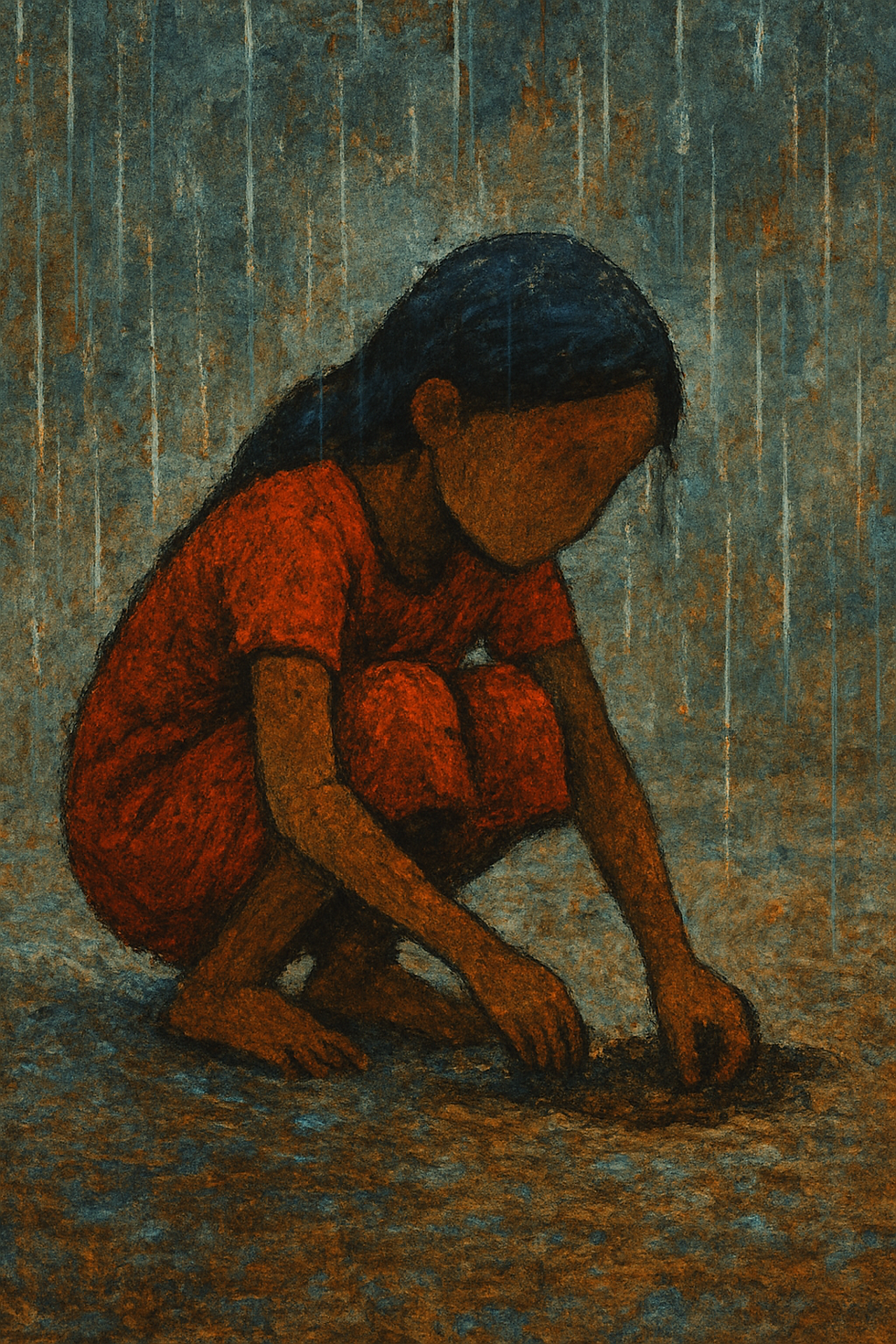The Girl on the Flyover
- Dr Madhusudan Nag

- Oct 8
- 5 min read
A chance interaction with a small child on a rainy evening has a researcher weigh in on challenges of survival and the lived reality of exclusion of migrant workers in urban India

Dr Madhusudan Nag

There are moments in a researcher’s fieldwork that do more than inform a study. They transform it.
And they do so by compelling the researcher to confront the harshness of lived realities.
For me, one such moment occurred during a Ph.D. field survey in Surat, Gujarat, in 2019. It was 5.40 p.m. on the fourth day of my back-to-back data collection for my research. Rains lashed the city as my autorickshaw stopped at a traffic-choked flyover.
As vehicles inched forward in slow desperation, my eyes caught an unusual sight. A little girl, no older than six or seven, stood near the edge of the flyover. She was stuffing old clothes, rags and plastic bottles into a hole in the flyover’s concrete. The wind blew fiercely, yet she persisted, her tiny hands working swiftly against the torrents of water streaming down.
Curious, I called out to her and asked what she was doing. She didn’t even look up as she answered.
"Main yeh chhed bandh kar rahi hoon, jisse paani nahi jayega niche jahan hum rehte hain." (I’m plugging this hole so the water won’t pour underneath, where we live).
I was silent as I let the import of her words wash over me. A hole in a government-engineered flyover intended as a conduit for vehicular mobility and urban efficiency was a direct threat to this child’s home. A civic structure meant to ease movement for the privileged was simultaneously a shelter for the dispossessed.
I stepped out of the auto-rickshaw, paid the fare, and shared my umbrella with her. She soon finished sealing the gap with whatever discarded materials she had gathered and brushed her wet hands on her soaked and oversized shirt. I asked if I could meet her family. She hesitated, then nodded, leading me down a narrow path beneath the flyover.
Life Beneath the Flyover
Under the pillars of Surat’s flyovers, a hidden city unfolded; one that remained invisible to the commuters who sped above it. Makeshift shelters of plastic sheets, tarpaulin, and discarded wood lined the damp ground.
There, five members of her family; her father, mother, two younger siblings, and herself, huddled together, trying to keep dry amid makeshift plastic sheets, tattered clothes and their few belongings stacked in bundles around them. A large cooking pot, blackened by soot, lay beside a pile of salvaged plastic bottles. They were migrants from Bihar, earning a living as ragpickers in the city.
The girl’s name, I learned, was Kiran, and her father, a thin but sturdy-looking man named Ramprasad Manjhi, greeted me with cautious warmth.
“Aisi town mein, hamaare jaisi kai sau families flyovers ke neeche rehte hain” (Hundreds of families like ours live under various flyovers in this town). The Manjhis, who had migrated from Gaya district in Bihar, carried with them a history of agrarian distress, caste landlordism, and state neglect.
“We left Bihar eight years ago,” he told me. His voice was barely audible over the rain. “No land. No work. Here, at least, we find enough plastic and scrap to sell.”
He went on to tell me that they belonged to the Musahar community, a Dalit sub-caste subjected to generations of bonded labour. Many Musahars had migrated to cities like Surat, Ahmedabad, and Delhi in search of survival. However, urban India, marked by deep inequalities and unfamiliar systems, offered them neither welcome nor space. The Manjhis found themselves caught between two exclusions: denied dignity in their native land and invisibilized in the city’s peripheries.
The Precarious Economy of Waste
Like thousands of migrant families in Surat, the Manjhis survived by scavenging recyclable waste, a profession known more commonly as rag picking. Each morning, Ramprasad, his wife Savita, and little Kiran walked through garbage dumps, railway tracks, and market lanes to collect plastic, glass, and metal scraps. Middlemen paid them a pittance; Rs 200 to 300 on a good day, barely enough to feed five mouths.
This informal waste economy, vital for keeping cities clean, rests disproportionately on the backs of caste-oppressed migrants. Yet, ragpickers remain excluded from formal recognition, social security, or labour rights. Instead, they face eviction campaigns and police harassment.
In 2018, for instance, an eviction drive for the ‘beautification’ of the Athwa Gate flyover rendered numerous families homeless. “The police arrived, threw our things around and ordered us to leave,” Ramprasad said. “But where do we go?”
Such drives, he went on to say, were hardly new. They occurred every few months, reminding families that their little world, which was fragile to begin with, will never be secure.
For the Manjhis, the flyover was the thin line between survival and destitution. But even this existence was fragile, threatened by the city’s relentless drive for “beautification.”
Childhood in a City That Refuses to See You
Kiran had never been to school. “She was born here. My youngest son, too,” her mother said. “We don’t have any papers.”
Without birth certificates or proof of residence, Kiran and her siblings were non-existent in the government’s records. The Right to Education Act promises free schooling for all, but in practice, access to this right demands documents, uniforms, and regular attendance. These are luxuries a child scavenging waste cannot afford.
Yet, despite the weight of systemic exclusions, Kiran navigates the city with a keen sense of awareness. She knew where to find scrap, which streets to avoid, and which shops might offer leftovers. When the leaking flyover threatened her home, she fixed it. Her unpaid, unrecognised labour was a form of survival. Every day, she helped clean a city that refused her the dignity of belonging.
(See also Human Rights Watch, Cleaning Human Waste (2014)).
The City as Caste
Surat’s gleaming flyovers are more than engineering projects; they are maps of inequality. Above, middle-class commuters speed in air-conditioned cars. Below, Dalit and Adivasi migrants huddle in shadows.
This division is not incidental; it is structural. Caste in India does not merely organise labour. It organises the very geography of cities. As B.R. Ambedkar wrote, caste is not just a division of labour, but a division of labourers. The Manjhis’ poverty was not accidental misfortune; it was produced by design, by urban policies that privilege capital, property, and elite mobility, while invisibilizing the very workers who keep the city running.
For more on this, see Malini Ranganathan, Caste, Racialization, and Environmental Unfreedoms in Urban India
The Moment That Changed My Research
When I first set out for my doctoral fieldwork, my project was largely quantitative. But after meeting Kiran, it became ethnographically informed. This encounter changed my research, and me.
After that, I returned often to the flyovers, documenting the hidden worlds beneath the pillars of progress: ragpickers, construction workers, homeless families. Over the next few months, I met construction workers living in unfinished buildings, women cooking on open stoves with firewood collected throughout the day, and little boys who balanced their studies with hours of manual scavenging. The fragments of their lives that I could witness during this time revealed how entire neighbourhoods had taken root in the shadow of urban development, while at the same time finding no place on any official map or municipal plan.
The more I studied this subterranean world, the more I realized that Kiran’s act of sealing a hole in a government flyover was more than childhood ingenuity. It was a refusal. A refusal to be displaced by a city that refused to acknowledge her.
This moment, and many like it, reshaped not only my research but also my understanding of urban India: beneath every swanky flyover lies a parallel city, one that the formal city would rather forget.
Dr Nag is a Senior Researcher at NIT Bhopal; Ph.D. (JNU); M.A. (UoH) and a researcher on development, labour migration, caste and city.





Comments